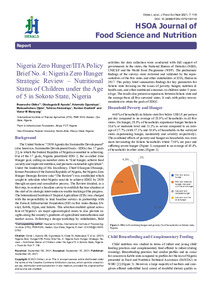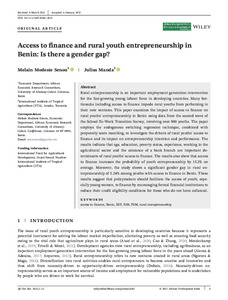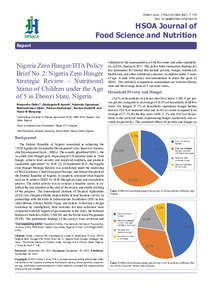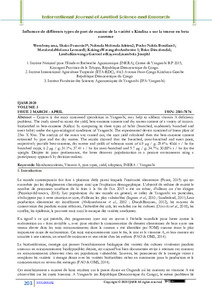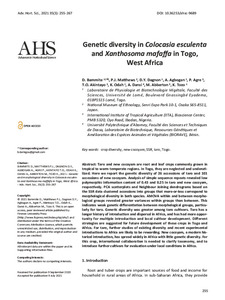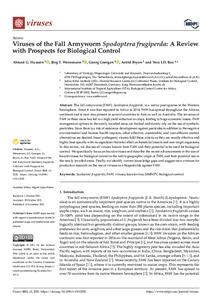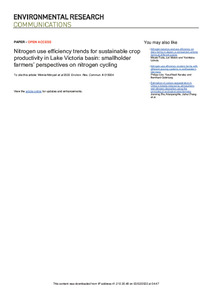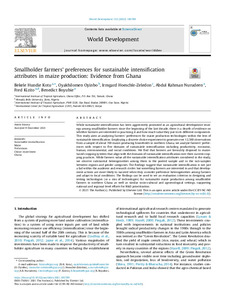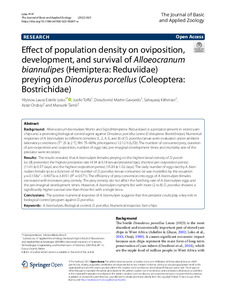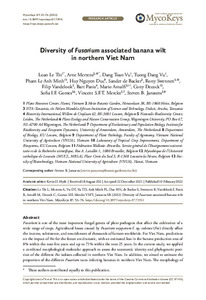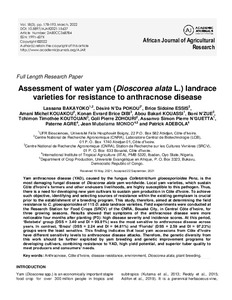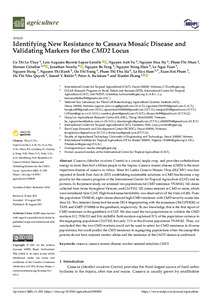Welcome to the International Institute of Tropical Agriculture Research Repository
Journal and Journal Articles: Recent submissions
Now showing items 861-880 of 5269
-
Unravelling causes of poor crop response to applied N and P fertilizers on African soils
(2022)A number of studies across sub-Saharan Africa have recently reported poor crop responses and low agronomic use efficiencies of applied nitrogen (AEN), phosphorus (AEP) and potassium (AEK). However, the conditions under which non-responsiveness occurs, its underlying causes and its probability of occurrence on different soil types are not well understood. Using data from 542 sites and 14 soil types in 23 African countries, we provide novel insights into the linkage between lack of response to applied ... -
Access to finance and rural youth entrepreneurship in Benin: Is there a gender gap?
(2022)Rural entrepreneurship is an important employment generation intervention for the fast-growing young labour force in developing countries. Many bottlenecks including access to finance impede rural youths from performing in their new ventures. This paper examines the impact of access to finance on rural youths' entrepreneurship in Benin using data from the second wave of the School-To-Work Transition Survey, involving over 900 youths. The paper employs the endogenous switching regression technique, ... -
Influence de differents types de port de manioc de la variete << Kindisa >> sur la teneur en beta carotene
(2020-03)Cassava is the most consumed speculation in Yangambi, may help to address vitamin A deficiency problems. The study aimed to assess the yield, beta-carotene content and dry matter content of a variety of cassava. biofortified in beta-carotene (Kidisa) by comparing its three types of habit (branched, moderately branched and erect habit) under the agro-ecological conditions of Yangambi. The experimental device consisted of linear plots of 25m X 50m. The analysis of the mean was carried out, the root ... -
Genetic diversity in Colocasia esculenta and Xanthosoma mafaffa in Togo, West Africa
(2021)Taro and new cocoyam are root and leaf crops commonly grown in tropical to warm temperate regions. In Togo, they are neglected and underutilized. Here we report the genetic diversity of 26 accessions of taro and 101 accessions of new cocoyam. Analysis of simple sequence repeats revealed low polymorphic information content of 0.43 and 0.25 in taro and new cocoyam, respectively. PCA scatterplots and Neighbour Joining dendrograms based on the SSR data clustered accessions into groups that moreorless ... -
Impact of youth-in-agribusiness program on employment creation in Nigeria
(2021)The increasing rate of youth unemployment in Africa, particularly in Nigeria, remains among the challenges to social and economic stability. Accordingly, the Nigerian government implemented several interventions, including the Youth-in-Agribusiness (YIA) program to reduce youth unemployment. However, the effect of these programs on gainful employment creation is yet to be documented. Therefore, this study examined the impact of the YIA program on creating gainful employment among the youth. ... -
Viruses of the fall armyworm Spodoptera frugiperda: a review with prospects for biological control
(2021)The fall armyworm (FAW), Spodoptera frugiperda, is a native pest species in the Western hemisphere. Since it was first reported in Africa in 2016, FAW has spread throughout the African continent and is now also present in several countries in Asia as well as Australia. The invasion of FAW in these areas has led to a high yield reduction in crops, leading to huge economic losses. FAW management options in the newly invaded areas are limited and mainly rely on the use of synthetic pesticides. Since ... -
Temperature influences on interactions among aflatoxigenic species of Aspergillus section flavi during maize colonization.
(2021)Fungal species within Aspergillus section Flavi contaminate food and feed with aflatoxins. These toxic fungal metabolites compromise human and animal health and disrupt trade. Genotypically and phenotypically diverse species co-infect crops, but temporal and spatial variation in frequencies of different lineages suggests that environmental factors such as temperature may influence structure of aflatoxin-producing fungal communities. Furthermore, though most species within Aspergillus section Flavi ... -
Antioxidant and starch-hydrolyzing enzymes inhibitory properties of Striga-resistant yellow-orange maize hybrids
(2021)Most of the health benefits derived from cereals are attributed to their bioactive compounds. This study evaluated the levels of the bioactive compounds, and the antioxidant and starch-hydrolyzing enzymes inhibitory properties of six pipeline Striga-resistant yellow-orange maize hybrids (coded AS1828-1, 4, 6, 8, 9, 11) in vitro. The maize hybrids were grown at the International Institute of Tropical Agriculture (IITA), Nigeria. The bioactive compounds (total phenolics, tannins, flavonoids, and ... -
Nitrogen use efficiency trends for sustainable crop productivity in Lake Victoria basin: smallholder farmers' perspectives on nitrogen cycling
(2022)Nitrogen Use Efficiency (NUE) is one of the established metrics for benchmarking management of Nitrogen (N) in various systems. Numerous approaches to calculate NUE exist, making it difficult to compare the performances of systems depending on the methodology used. This study adopted the conceptualized framework by European Union Nitrogen Expert Panel (EUNEP) to calculate NUE values for cereal crops to determine future trends for the first time in the Lake Victoria region. Data were collected ... -
Smallholder farmers’ preferences for sustainable intensification attributes in maize production: evidence from Ghana
(2022-04)While sustainable intensification has been aggressively promoted as an agricultural development strategy among smallholder farmers since the beginning of the last decade, there is a dearth of evidence on whether farmers are interested in practicing it and how much value they put to its different components. This study aims at analyzing farmers’ preferences for maize production technologies within the lens of sustainable intensification. Employing a discrete choice experiment to generate over 12,500 ... -
Effect of population density on oviposition, development, and survival of Alloeocranum biannulipes (Hemiptera: Reduviidae) preying on Dinoderus porcellus (Coleoptera: Bostrichidae)
(2022)Background Alloeocranum biannulipes Montr. and Sign.(Hemiptera: Reduviidae) is a predator present in stored yam chips and a promising biological control agent against Dinoderus porcellus Lesne (Coleoptera: Bostrichidae). Numerical responses of A. biannulipes to different densities (1, 2, 4, 6, and 8) of D. porcellus larvae were evaluated under ambient laboratory conditions (T°: 25 ± 2 °C; RH: 75–80%; photoperiod 12:12 h (L/D)). The number of consumed prey, duration of pre-oviposition and oviposition, ... -
Diversity of Fusarium associated banana wilt in northern Viet Nam
(2022)Fusarium is one of the most important fungal genera of plant pathogens that affect the cultivation of a wide range of crops. Agricultural losses caused by Fusariumoxysporumf.sp.cubense (Foc) directly affect the income, subsistence, and nourishment of thousands of farmers worldwide. For Viet Nam, predictions on the impact of Foc for the future are dramatic, with an estimated loss in the banana production area of 8% within the next five years and up to 71% within the next 25 years. In the current ... -
Assessment of water yam (Dioscorea alata L.) landrace varieties for resistance to anthracnose disease
(2022-03)Bakayoko, L., Pokou, D.N., Essis, B.S., Kouakou, A.M., Dibi, K.E.B., Kouassi, A.B. & Adebola, P.O. (2022). Assessment of water yam (Dioscorea alata L.) landrace varieties for resistance to anthracnose disease. African Journal of Agricultural Research, 18(3), 178-193. Abstract: Yam anthracnose disease (YAD), caused by the fungus Colletotrichum gloeosporioides Penz, is the most damaging fungal disease of Dioscorea alata yam worldwide. Local yam varieties, which sustain Côte d'Ivoire’s farmers and ... -
Effects of inter-row spacing on growth, seed yield and yield components of Soybean (Glycine max) in Makurdi, Benue State-Nigeria
(2021-05)Despite the numerous benefits of soybean, its grain yield per unit area in Nigeria is low estimated at 1.2 tons ha-1 compared to the worldwide average yield of 2.5 tons per hectare. The low yield is due in part to limited use of phosphorous fertilizer and poor crop management practices including low plant populations. Farmers in northern Nigeria including Benue State sow seeds in rows spaced 75cm. There has been little recommendation as to the exact row spacing that will give higher yield in soybean ... -
Identifying new resistance to Cassava Mosaic Disease and validating markers for the CMD2 locus
(2021)Cassava (Manihot esculenta Crantz) is a crucial staple crop, and provides carbohydrate energy to more than half a billion people in the tropics. Cassava mosaic disease (CMD) is the most important disease of cassava in Africa. Since Sri Lanka Cassava Mosaic Virus (SLCMV) was first reported in South East Asia in 2015, establishing sustainable solutions to CMD has become a top priority for the cassava program at the International Center for Tropical Agriculture (CIAT) and its partners. In the present ... -
Potential of Metarhizium anisopliae and Beauveria bassiana to control Dinoderus porcellus (Coleoptera: Bostrychidae) infesting yam chips
(2022-06)The beetle Dinoderus porcellus Lesne is a serious storage insect pest that causes important losses by destroying stocks of yam chips. In the aim to found an alternative control method to the use of synthetic insecticides for its management, the virulence of the entomopathogenic fungi Beauveria bassiana (Balsamo) Vuillemin (isolate Bb115) and Metarhizium anisopliae (Metschnikoff) Sorokin (isolate Met 31) against adults of D. porcellus was evaluated under laboratory conditions (25 ± 2 °C and 70 ± ... -
The phosphate inhibition paradigm: host and fungal genotypes determine arbuscular mycorrhizal fungal colonization and responsiveness to inoculation in cassava with increasing phosphorus supply
(2021)A vast majority of terrestrial plants are dependent on arbuscular mycorrhizal fungi (AMF) for their nutrient acquisition. AMF act as an extension of the root system helping phosphate uptake. In agriculture, harnessing the symbiosis can potentially increase plant growth. Application of the AMF Rhizophagus irregularis has been demonstrated to increase the yields of various crops. However, there is a paradigm that AMF colonization of roots, as well as the plant benefits afforded by inoculation with ...


